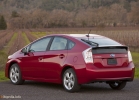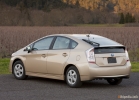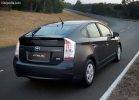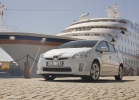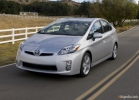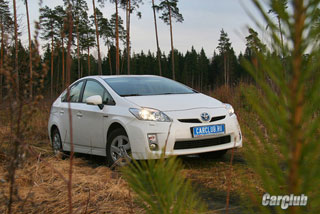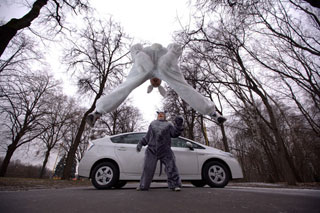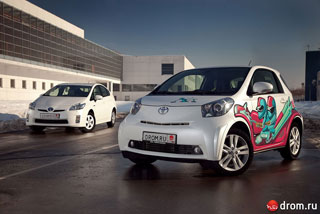Toyota Prius test drive since 2009 hatchback
New Prius - we won the championship on it!
We are used to measuring our country the most epithet. The largest, most powerful. But small Sweden, without imperial complexes, can also boast of a few, although not with such loud records. For example, in Sweden the largest number of horses in private ownership per capita. And the largest number of Toyota Prius hybrid cars for the same sophisticated Swedish soul. To be precise, six cars per thousand inhabitants. It is not surprising that the presentation of the new generation (third in a row), Toyota arranged in Stockholm.Arland’s airport did not meet with sunny weather and convincing requests ... to beware of pickpockets. Having left the airport building and hoping to see the column of new Prius prepared for the test, we rested in a series of old produces. It turns out that the Japanese hybrid is the most popular car among Swedish taxi drivers along with local Volvo. And this is understandable. After all, the previous priece has an average consumption of about four liters per hundred. And one liter of 95th gasoline is in Sweden in terms of our money about 50 rubles! The desire of carriers to save on fuel is completely clear.
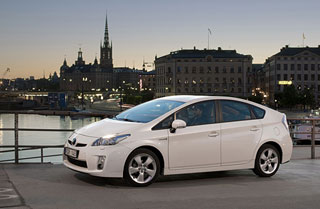
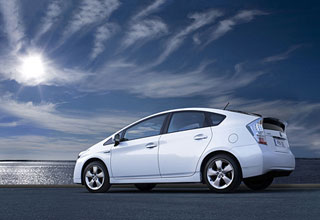
A hybrid or combined drive (DIC plus motor generator) provides greater efficiency due to the possibility of re-using the kinetic energy of a moving car. In a conventional car during braking, the energy of movement using brake mechanisms is converted into heat and dissipated into the surrounding space. A hybrid drive during braking allows the gratuitous mechanical energy by means of a generator motor to convert it into an electric one and accumulate it (of course, with some losses) in the batteries. At the right time (with unhurried movement in traffic jam or acceleration), the energy stored in batteries will be used again
Snow -white third produces, standing next to the old, their sharp faces of the body and a new silhouette chained the views of absolutely all taxi drivers. The car would have become a lot! At the same time, a number of family features made it possible to maintain complete recognition. An extremely successful stern design hardly touched. The cabin shifted slightly back, the hood lengthened, the car ceased to be a groomed tadpoles, gained previously the dynamism and balanced.
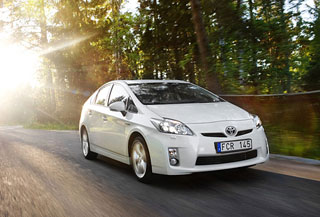
The aerodynamic resistance coefficient of the new priest is 0.25. Both previous generations boasted 0.26
The maximum configuration includes such technical sweets such as active cruise control, a system for projecting data on windshield, contactless access, navigation, automatic parking system, and even an integrated solar battery (used during the parking of fans that support air circulation In the cabin to the air conditioning, it is not enough). But you will not see electrical drives of seats adjustments even on the most expensive performance. However, nothing strange creators needed to maximize the cost. It is necessary to sacrifice something. Savings are also felt in the finish along the perimeter of inexpensive plastic, though here it is no longer as ringing and slippery as in the previous generation.
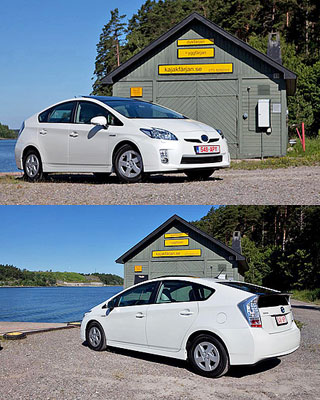
Cars without a solar battery with a hatch and 15-inch wheels will be supplied to Russia. In Europe, the USA and Japan, variations with 17-inch wheels are available
If earlier all the information of navigation, climate and operating modes of the hybrid scheme was displayed on one display, now it is displayed by three. At the very bottom, the usual monochrome strip of climatic installation. A little higher, navigation touch monitor. The system with not the best interface, but it is clear and furious working, disappointed with low sensitivity to touch.
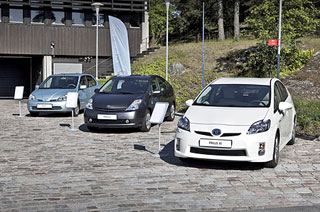
The first generation Prius (left) was published in 1997. Prius II replaced in 2003. The third generation debuted at the beginning of this year at the Detroit car dealership
The upper floor is divided into two zones. In the left digital speedometer and the indicator of the instant fuel consumption. Here is an interesting find of engineers. If you press on any key on the steering wheel, on the dashboard, two blue rounds will appear, as if hanging in the air, they duplicate the pressed buttons. Beautifully and comfortably blindly feel the steering wheel. In the right side, the silhouette of the Prius with animated energy flows, the indicator of the permanent fuel consumption over the past half hour and the flowmeter.
We press the Start Voyototovskaya button and in response ... silence. A car that has a full charge of the battery moves on an electric vehicle up to a speed of 70 km/h (if you do not need to warm the cooled salon in cold weather). Two operating modes of hybrid installation are provided: ecological Eco Mode and dynamic PWR Mode. They radically change the character of the car. In the Eco Mode mode, the Prius saves fuel and slowly gains speed. Only a sharp pressure of the gas pedal (it is naturally electronic) to the floor allows you to get acceptable acceleration.
In PWR mode, the prose almost instantly responds to the accelerator with a powerful acceleration. If you stomp well along the pedal, a 1.8-liter engine operating on the Atkinson cycle goes out at a maximum power and hangs on them. At this time, a hybrid electromechanical transmission smoothly, like a variator, changes a gear ratio. Ten seconds, and now a hundred. Powerful acceleration continues up to 140 km/h, but then the intensity of acceleration is significantly reduced. 160 they are no longer so fun, but to the limiter (180 km/h) to crawl, it seems, eternity. At the same time, it is clearly felt that the chassis can work adequately at speeds for two hundred.
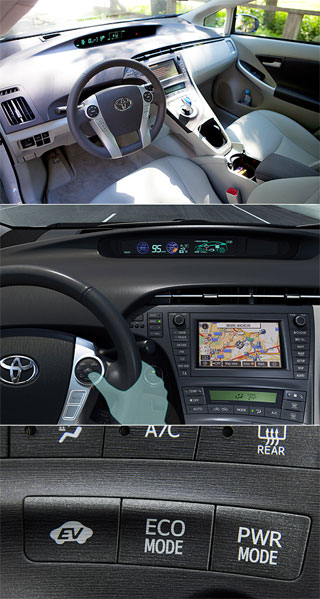
The concept of concentration of readings on the central dashboard remained. You need to get used to it only the first few minutes
Drive with a spark, the smell of burned rubber and braking on the floor is not for Prius. He, in principle, can, but does not like it all. The hybrid enters the turn with small rolls, but confidently and predictably. The squeaks begins to plow all the tires at once the stabilization system allows you to slip a little. The smoothness of the course is somewhere between comfortable and sports. Everything is in the prose correctly and verified. But ... does not catch! As if engineers received a technical assignment that did not interest them at all. According to Japanese mentality, they performed it efficiently, but without a spark.
Imagine our surprise when we, having arrived at the next check-point (its organizers entered the navigation system in advance) learned that nothing but a racing special facet awaits us! How so, we came to test a family environmentally friendly car, and not a new generation of Celis! Why is it?
Everything fell into place when they explained to us that the rally would be environmental, and we have to compete not for a while, but for the minimum fuel consumption. As a guideline, we were announced that factory testers were able to show a record at a 20-kilometer section of 3.2 liters per 100 km, and the record holders of three weeks of tests from Croatia achieved unimaginable 2.3 l/100 km!
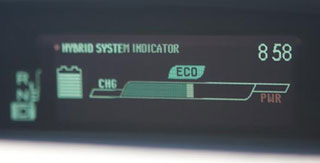
Certure. A long strip is divided into four zones. A pointer is moving along it, notifying how economically you are going now. You are the most left -hand sector in recovery mode, that is, now the car replenishes the battery charge. The second sector is economical hybrid. If the pointer is in its zone, then most likely you are now moving at the expense of the electric motor. The third site mode is when both engines are pulled together. Well, the fourth is Power Zone, stating that the driver began to blame all the money
Okay, I transplant my companion from National Geographics to the passenger seat. The paths of the path and consumption indications are reset. Gearbox in economical mode. To start, attention, green light! Cars, like sluggish turtles, nailed by a random north sun, crawled out of the parking lot and rolled down on a hilly narrow road. The competition, on the contrary, has begun!
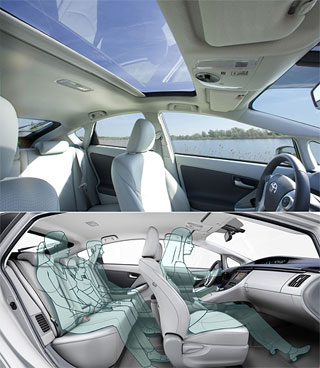
The front seats, devoid of good side support, are kept mediocre in corners. The situation is aggravated by slippery skin. Instead of a convenient Minivan passage between the front seats in the new prose, now a high tunnel. Through the dentiles, which are located on the sides of the rear seat, air for cooling it enters the traction battery to cool
It is easy to regulate the level of electricity and gasoline consumption in Prius, a flow meter scale helps. The first three kilometers passed with a consumption of 0.1 l/100 km. But the road is mainly uphill, so the electric charge ended quickly. Now, on particularly steep lifts, ICE is turned on, and the consumption instantly jumps to 2.62.8 l/100 km. The descent, the car goes into the recovery mode, the consumption is reduced to 2.32.4 l/100 km. The main thing is not to feel sick, as some colleagues do. We overtake them, because the smallest speed is not at all the key to victory. I support cruising 5055 km/h, I try to take off on the hills and do not slow down in any case on the slopes. But still, we have gathered a column of angry Swedes. They, law -abiding, overtook us only in rare allowed places, buzzing and emotionally showing indecent gestures. Thank God that our cars were Belgian numbers! I can imagine what local residents now think about the Belgians, if for three weeks they met stubbornly crawling along the surrounding hills of Tikhokhod.
Meanwhile, the finish is approaching, and the consumption at the mark of 2.4 l/100 km. Need to do something. Yeah, we have four more strips of energy in reserve, we must use them! Therefore, the last couple of kilometers we literally crawled to the finish line, consuming only electricity, and not precious drops of fuel. 2.4. 2.3. 2.2 !!! And here is a check-out with marshals fixing the result. How much do you have? 2.1? Oh my God! This is a record! And the average speed? 35 km/h? Great, this is a victory! Hey, Paskual, \u200b\u200bthese guys made 2.1!.
We won and became the most economical crew among all European countries! Those very guys from Croatia are in second place, and our colleagues from the author and the Russian version of Topgear closed the top three of the winners.
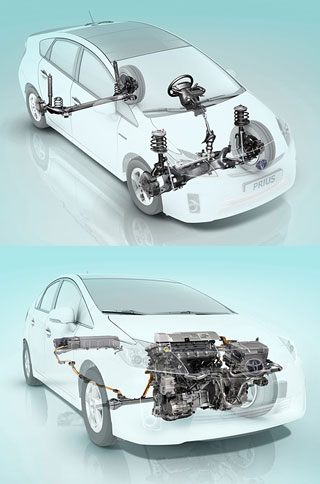
The Prius chassis with engineering delights does not shine. In front, an independent McPherson suspension was installed, semi-dependent behind with an N-shaped beam. The power plant with control electronics is combined in one block and is located above the front axle, the traction battery is installed in the rear part behind the rear seat
So why is the new Prius good? Is it only efficiency? As the Toyotovites admit, for Russians this will be the most important argument. After conducting special studies in Russia, they calculated that for only a third of buyers the environmental factor is important. Indeed, in our country, few people without hesitation will answer the question: 89 grams of carbon dioxide ejected into the atmosphere per kilometer of the path traveled is this a lot or a little?
In the West, the minimum emissions of harmful substances are the main argument when buying a car. And the point here is not only in the green worldview. Now in almost all countries there are significant subsidies and tax relief to the owners of hybrid cars. And overpayment for technology is compensated by the government. Confirmation of the 1.2 million Prius, which has dispersed around the world. Russia moves its sovereign path, and does not think about such trifles. But, the issue of reliability is extremely important to us. And then the Japanese have something to please fans of the brand. It turns out, according to Toyota, the owner of Prius appeals to the service with breakdowns is four times less common than the owners of other models of the company! At the same time, regulatory maintenance costs as much as, for example, for Avensis. The batteries live the entire service life, and frosts up to 50 degrees Celsius are completely not afraid of them.
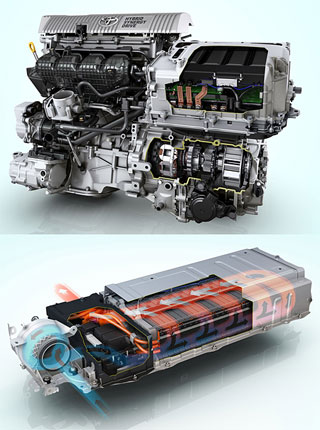
A 1.8-liter internal combustion engine operating in the Atkinson cycle and equipped with a gas distribution phase adjustment system, develops the maximum power of 99 hp. at 5200 rpm and 142 Newton-meter of torque at 4000 rpm. The Generator in traction mode issues 82 hp. (60 kW) and moment 207 nm. The total maximum installation capacity is 136 hp Perei 200-volt nickel-metallogloglogram battery is located behind the rear seat and has forced air cooling
The Toyotovites worked out especially carefully, not for nothing in Scandinavia and Canada, the highest percent of Prius sales. A special heating system of coolant with exhaust gases allows you to warm up the engine much faster. Previously, at 5 degrees Celsius Prius heated completely in twenty minutes. Now five are enough!
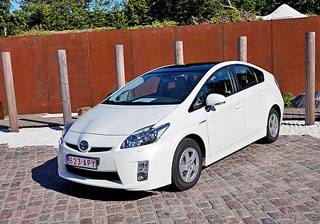
For all the time of the test, I have not been able to get out of the average consumption of 3.9 liters per 100 km. Only when I checked the dynamics, the consumption amounted to about 6 liters. A 45 liter tank is enough when driving more than 1100 km
And now about the most important thing. When and how much? When you can already say definitely in the fall. The first cars will appear in the showrooms of Russian dealers in September. We still have no information about the prices, but we can definitely say that there will be no cheap car. In the States, the easiest Prius costs $ 22,000, which means that our price will be about $ 40,000 (recall, for a less technological Honda Insight hybrid car in the United States, they ask $ 18,500). It is already known now that the Russian specifications of Prius will be deprived of such interesting options as active cruise control (the frequency of radio waves is reserved for special services) and a climatic installation feeding on the solar battery. How many people who want to buy, albeit high -tech, environmentally friendly, economical, but still a middle class Toyota for almost $ 40,000?
Thomas Gödel is 46 years old. Taxi driver
At Prius, I moved with Volvo S70 more than three years ago. Then our entire company moved to these hybrids. At first it was scary how the car would behave in our, not the softest climate. But now we remember Volvo as a nightmare. On my Prius I drove about 150 thousand kilometers, and besides supplies in the car, they did not change anything. The company has a mileage for 250 thousand kilometers, so they, too, have not yet been out of order. The car is spacious for passengers, although I would like more places in the trunk. But gasoline consumption pleases. Even in winter, fully loaded eats no more than six liters
Types of hybrid drives
At the moment, several hybrid schemes are used in the automotive industry. The composition of a parallel hybrid scheme (this is the Honda Insight), which helps the gasoline unit to disperse the car. The internal combustion engine and the generator in a parallel hybrid scheme have a rigid mechanical connection. This scheme is less complex and less expensive in production, a more compact and lightweight traction battery is used to power the electric motor. Such a hybrid drive is less economical and less environmentally friendly. In parallel, a hybrid scheme cannot work in an electric car mode.
A sequential hybrid system (like Chevrolet Volt) allows you to move only on an electric motor. ICE at the same time always charges batteries and works in established mode. The disadvantages of such a scheme are the need to install a large and heavy battery, as well as the worst power indicators and more sluggish dynamics. Plus environmental friendliness and efficiency, since the internal combustion engine works at the most favorable speeds, harmful transition and power regimes are excluded in this case.
Prius with a combined hybrid drive Hybrid Synergy Drive (HSD) is driven from a gasoline engine and electric motor. Prius up to 70 km/h, like an electric car, is capable of mainly not electric trustees. Intensive accelerations are provided by the joint work of both engines (they can work from the very start). Hybrid Synergy Drive has the energy -saving advantages of models with a consistent hybrid system (high fuel efficiency and low toxicity of waste gas) and good power indicators.
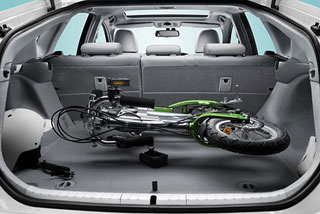
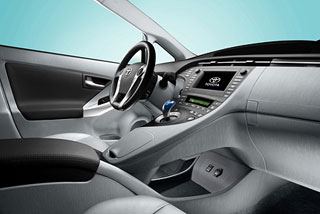
Text: Gleb Hoyt
Photo by the author and company Toyota
A source: Auto.mail.ru

